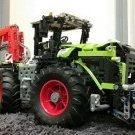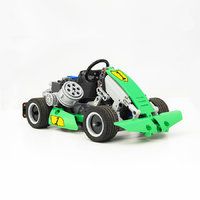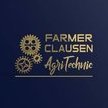Search the Community
Showing results for tags 'agriculture'.
Found 19 results
-

[MOC] John Deere SESAM 2 tractor
MP LEGO Technic creations posted a topic in LEGO Technic, Mindstorms, Model Team and Scale Modeling
It might seem that the field of agriculture is not much affected by the boom of modern technologies, but it is precisely in agriculture that a rapid development of automation and robotization is expected not only in the processing of crops, but also in their cultivation. For this reason I have decided to build something different this time - namely an official autonomous concept of a John Deere tractor called SESAM 2. This one differs from other visions in particular by the possibility of attaching the driver's cabin and the ability to work both in a purely autonomous mode or be remotely/directly controlled from its cabin. In the field, the cab can be detached at the headland, allowing the operator to monitor and possibly control the tractor. The efficiency is further increased by the ability to work in a swarm, so it is possible to monitor or control several machines working in the same field from one cabin. Since the real tractor has a power of 500kW, I decided not to use just one motor to drive it, but two. In terms of shape, the so-called large angular motor is suitable for the model of this particular tractor, because it enables better use of space - i.e. the possibility of placing it vertically on both sides of the chassis between the axles, thereby freeing up space in the center of the model, which can subsequently be used for other functions. A central differential is usually used to compensate for the difference in wheel speeds of the front and rear axles due to their different diameters, however the disadvantage of this variant is that if one of the wheels of the front axle is not in contact with the ground, all the power of the drive system will go to this wheel and the model will stop. By inserting suitable gears, the speed difference will be equalized, so it is possible to replace the central differential with a fixed connection of the drive shafts of both axles. Thanks to the drive motors located on the sides of the central frame, it is possible to add a mechanical locking rear differential working on the basis of a centrifugal regulator in conjunction with another differential used to compare the revolutions of individual wheels (note: each of the output shafts of the drive differential is connected to the output shafts of the "control differential", but one of them utilizes higher number of gear wheels, so when both shafts of the drive differential are at the same speed, the "control differential" does not move) of the rear axle - if the difference in the speed of the two wheels is too high, this differential connected to the centrifugal regulator also turns, with a higher centrifugal force with the arms of this regulator will begin to lift until they are far enough away from each other that the surrounding parts prevent them from further moving away, thereby blocking the entire regulator. This will stop the "control rear differential" from rotating and close the drive differential. CREDIT goes to @JoKo, I just loved his brilliant idea so much that I decided to build a model around it My original design of steering included a gear rack, but it turned out to be inaccurate in practice, and the range of the wheels was greatly limited. Therefore, it was necessary to come up with a new concept - control of the steering connecting rod using a small LA. This solution is features in particular a higher force for controlling the wheels with a reduced engine load, greater steering angle, improved accuracy and protection of the motor in extreme positions thanks to the internal safety element of the used LA. In addition, the entire axle is pendular to achieve better offroad ability. The only pneumatic circuit uses a classic pump+switch combo: A Medium angular motor is used for the rear PTO. Since a variety of implements can be attached to the tractor and there is no space left to build in any speed gearbox I have decided to use not one, but two coupled PTO outputs, which differ from each other in their speeds. The front hydraulics is driven by another Medium angular motor, and sufficient load capacity is ensured by a worm gear. Similar to the front three-point hitch, the rear hydraulics use a worm gear, with the Angular motor replaced by a more powerful Control+ L motor, as heavier equipment is attached to the rear. When talking about lighting - John Deere is based in the US, where red turn signals are common, so it is possible to use the same LEDs for both tail lights and turn signals. Blinking is solved by software changing the intensity, where the direction lights flash in short time intervals with 100% intensity, while the rear lights only shine at half power. A small addition are two glow-in-the-dark stripes on both sides of the machine, which do not require any electric connection. All "autonomous" features are in fact a mere Mindstorms distance sensor. Schematic layout of mechanical functions: Schematic layout of the mechanical functions, including the respective motors (both HUBs are located above the front axle, due to which it is heavily loaded and, together with the powerful drive system, ensure exceptional traction capabilities): Complete tractor chassis: At first glance, it might seem that the shape of the selected tractor is simpler than that of classic tractors, but upon closer observation it becomes clear that even apparently flat surfaces are curved, slanted or otherwise modified. Designing the model is also greatly hampered by the lack of visual material. All searchable photos are just a snapshot of a certain part of a not-so-long video. This video, along with the minimal amount of information published, is the only source from which the LEGO model was designed. The chassis of the production 6R series tractor gave a slight idea of the dimensions, but the body design was purely based on my own experience. Since the cabin will often stand on the ground, I came up with the idea of equipping it with rubber pads, which not only dampen the impact when it is placed, but also provide it with better stability even on uneven surfaces due to higher friction. The interior is equipped with small details, such as an adjustable steering wheel collumn and armrest or a lockable storage space under the folding passenger seat. Various devices can of course be attached to this tractor - here is, for example, Rolland Rollspeed 7136 trailer: To the controlling app - on a mobile device (tablet) the Mindstorms application will be directly connected to one of two HUBs in the model, which will directly control the motors connected to this HUB, while on the other HUB a stored program will be run waiting for the start signals that will be forwarded to it from tablet through the first HUB and their mutual (HUB-to-HUB) communication. And for more convenient control, I also used the Sony Dualshock 4 game controller. Program streamed to HUB 1: 1) Control of rear and direction lights 2) Front axle steering 3) Sending a signal for HUB 2 - turning on the front lights with the brightness value "light brightness" (14) 4) Setting the value of the "sensor" variable needed for its activation/deactivation 5) Forward/backward control along with obstacle detection and emergency stop (15) 6) Sending a signal for HUB 2 – starting the PTO in one way 7) Sending a signal for HUB 2 – starting the PTO in the other way 8) Sending a signal for HUB 2 – starting the pump in one way 9) Sending a signal for HUB 2 – starting the pump in the other way 10) Sending a signal for HUB 2 - lowering the front three-point hitch 11) Sending a signal for HUB 2 – raising the front three-point hitch 12) Sending a signal for HUB 2 - lowering the rear three-point hitch 13) Sending a signal for HUB 2 – raising the rear three-point hitch 14) Setting the value of the "brightness of the lights" variable needed to turn them on/off 15) Setting the value of the "stop" variable for turning on/off the emergency brake Program stored in HUB 2: 1) Signal reception from HUB 1 – turning on/off the front lights 2) Signal reception from HUB 1 – lowering/raising the front three-point hitch 3) Signal reception from HUB 1 – lowering/raising the rear three-point hitch 4) Receiving a signal from HUB 1 – starting the PTO in one or the other direction 5) Receiving a signal from HUB 1 – starting the pump in one direction or the other Some dimensions: Length (without cab/with cab): 360mm/445mm Width (without cabin/with cabin): 180 mm/225 mm Height (without antennas/with antennas): 184 mm/218 mm Wheelbase: 160 mm Wheel track (front/rear axle): 136 mm/136 mm Weight: 2660 g (Without cabin); 3035 g (With cabin) Proportional axle load: Front - 55%; rear - 45% Load capacity of three-point hitches: Front - 626 g; Rear - 565 g (well, that's definitely interesting ) The model consists of a total of 2950 original parts, while I managed to build in the following features: • all-wheel drive (2x Large Angular motor) • automatic rear differential lock • front axle steering (1x C+ L motor) • swinging front axle • front three-point hitch (1x Medium Angular motor) • rear three-point hitch (1x C+ L motor) • auxiliary drive of implements (1x Medium Angular motor) • pneumatic drive of external devices (1x C+ L motor) • front and rear lighting (4 pairs of LED lights) • obstacle detection and automatic braking systém (Distance sensor) • remotely detachable cab with movable interior details • robust bodywork with easy access to control units Link to WIP topic: I hope this post has not somehow exceeded the maximum allowed length or anything like that Thanks for visiting & comments are welcome!- 22 replies
-
- agriculture
- farm
-
(and 2 more)
Tagged with:
-

[WIP] John Deere SESAM 2 + Rolland Rollspeed 7136
MP LEGO Technic creations posted a topic in LEGO Technic, Mindstorms, Model Team and Scale Modeling
I know that I shouldn't start another build before finishing all those previous ones but you know, when you get an idea, you sometimes just can't resist... Well, this time it's an electric tractor - John Deere SESAM 2 (Sustainable Energy Supply for Agricultural Machinery) because I've realized that it would be useful to have something to pull a trailer full of harvested "beets" from my ROPA harvester. I've decided to build this specific one because I wanted something that no one has built before (presumably) and I find this concept quite interesting as well. The problem I've faced from the very beginning is lack of any documentation - I can only build according to the video below (and photos that are mostly from this video). All I know is that it is based on a 6R tractor and its cabin comes from some kind of a harvester. The idea si that it can work as an autonomous tractor as well as a classic tractor (well, you can attach a cabin ) I also wanted to try designing a model in digital form before ordering all those expensive green parts This is where I got: Powered by 2 Mindstorms RI Hubs 7 motors (already placed), a distance sensor at the front and 4 pairs of lights (front, rear and indicators) 4WD with central differential and automatic rear diff lock (@JoKo will know ) by 2 Large Angular motors Steering via 1 C+ L motor Rear PTO (1 Medium angular motor) Front hydraulics (1 Medium angular motor) Rear hydraulic (1 C+ L motor) Sariel's pneumatic pump with switch for power output Pendular front axle First prototype of the front grille: Cabin: The internals: I know, it's already quite crammed inside but as I've already built it IRL, I'm really satisfied with the result! Everything seems to work well, the drivetrain is efficient (thanks to batteries at the front it can easily pull heavy objects) The only thing that isn't that fantastic is the diff lock (as many of you definitely spotted even in the beginning) - it works well, however it's only useful when one of the rear wheels is lifted off the ground. I can only pray that the front pendular axle will always copy terrain and have enough traction at anytimes I hope I'll manage to make a few photos of the real thing this week. Thank you for reading & comments with any suggestions are welcome as always!- 41 replies
-
- agriculture
- tractor
-
(and 2 more)
Tagged with:
-

[WIP] Bednar Swifter SN3000 seedbed cultivator
MP LEGO Technic creations posted a topic in LEGO Technic, Mindstorms, Model Team and Scale Modeling
Hello everybody! A few days ago I started to build a seedbed cultivator from Czech manufacturer Bednar FMT. Its real working width is 3 meters (that's why SN3000). The model's width is exactly 25 cm (scale 1:12). Here's current progress: Thank you for visiting this page. & Comments are welcome. -
The grain silo has been a landmark across the North American breadbasket since the railroads moved west. For my layout, I built a small setup on a 32x32 baseplate. The roof over the grain load/unloading area is removable for play value at shows. Additionally, one wall is removable so the interior (including grain elevator) is visible. The brick built ear of corn is based on design on the combine harvester from 2009.
- 3 replies
-
- grain
- agriculture
-
(and 1 more)
Tagged with:
-

[WIP] ROPA Tiger 6s beet harvester
MP LEGO Technic creations posted a topic in LEGO Technic, Mindstorms, Model Team and Scale Modeling
EDIT : It's no more the Panther 2 but the Tiger 6s, please scroll down for further information. Hello everybody. A few weeks ago I've started to build a German sugar beet harvester ROPA Panther 2 in 1:17 scale. Here is the fourth version of the chassis and its features (still far away from completion): 2 C+ Smart Hubs (first is for steering and drivetrain and second is for other functions - not finished yet) 2 C+ XL motors for drivetrain (front and rear axle aren't connected together) 1 C+ L motor for front axle's articulated steering 1 C+ XL motor for rear axle's steering Pendular rear axle Front hydraulics operated via 2 short thick pneumatic cylinders Automatic security levers connected to rear steering I'd like to make it fully working (put some bricks on the front belt to go through the whole mechanism and fall into the container), everything works except the cleaning section (no idea how it will work yet) So a lot of work still left to do.... Thank you for visiting! & Comments are welcome. -

[WIP] Inspired by older CASE IH Magnum 7140 (New progress photos)
MP LEGO Technic creations posted a topic in LEGO Technic, Mindstorms, Model Team and Scale Modeling
Hello everybody. Here's my WIP moc of Case IH Magnum 340 CVX. Controlled by Control+ More photos soon, currently testing.- 15 replies
-
- agriculture
- farm
-
(and 3 more)
Tagged with:
-

[WIP] Cultivator inspired by Bednar Swifter SM18000
MP LEGO Technic creations posted a topic in LEGO Technic, Mindstorms, Model Team and Scale Modeling
Hello everybody. I have started to build a cultivator. It won't look exactly like the Bednar SM18000 but it'll be very similar and it'll also have many of its features. Here's a pic of original and a product video by Bednar Machinery: -

[MOC] agria 9600 - High Grass Rotary Mulcher & Snow Plow
Baumi2019 posted a topic in LEGO Technic, Mindstorms, Model Team and Scale Modeling
Hi LEGO fans, this is my MOC I currently built/constructed and post to LEGO IDEAS. It's a rebuild from the original agria 9600-112 Hope you like it and vote for me! More informations and pictures at: Agria 9600 RC - High Grass Rotary Mulcher & Snow Plow Best regards Baumi- 1 reply
-
- agria 9600
- agriculture
-
(and 4 more)
Tagged with:
-

[MOC] Kverneland FastBale - Non stop Haybaler
Carsten Svendsen posted a topic in LEGO Technic, Mindstorms, Model Team and Scale Modeling
Finally, I've had enough time to finish this creation and the associated video. It only took 2 years since it's conception, but I've had a lot of breakdowns in between. There were so many difficult challenges that I had to overcome, that the list would be too long for anyone to read it. Some of the main solutions that I'm proud of are: Using small pneumatic air pumps for the pre chamber. I went through a million iterations of different liftarm and brick arrangements before I finally looked in my pneumatic parts The knives cutting the net was tough since it had to be low profile while still maintaining travel distance Having either side of the main chamber interact with the pre chamber in sequence regarding resetting of pneumatic valves was probably my greatest achievement The independent pneumatic setup was quite a headache to figure out as there are a lot of possible ways to connect hoses and to make sure there is no unwanted air bleeding from the valves Lastly, the big power puller wheels are not meant to be attached from the outside, causing them to greatly sag and not function well. This was solved using an array of pins and towballs behind the rim The chambers were the very first thing to be built. I counted the amount of rollers needed from the official blueprints, then made circle cut outs and build a brick cage around the gears. Studded construction is certainly not my speciality which came to show later on in the end during the aestethic finish. This is also where I tried to make sense of highlighted colors for the functions: RED for valves YELLOW for key elements DBG to make functions stand out from the chassis GREEN for the net STICKERS for a realistic look - These were all taken from set sheets I also set a goal to myself of using some of the rarely used parts that comes or used to come in the Bionicle sets. This includes 4x Visorak Torsos (frame), 2x Bohrok Shoulders and 2x connector blocks with 6 axleholes (Wrapping table). Unfortunately I found no use for widely discussed 5x6x2 perpendicular fork with 3 fingers, except on my crude make-shift tractor. If there's anything you want to know or see, do not hesitate to ask, as I will never take this apart, and I can take as many extra pictures as needed i The circuit diagram tool can be found on this website. It has been much valued throughout the whole process. Note: This picture is an old WIP, but here you can see the internals More pictures can be found on my imgur gallery In the beginning I tested out different parts for the pickup to see which ones best pick up cut dried grass, and the rotor blades proved the best in this test. However, I would not try and actually make a haybale in this machine as there are several flaws: The plastic chain is certainly not meant for any sort of load and snaps if caught on something, which would be stuck rollers and therefore gears because of the hay There are gaps in the construction - Though I've tried my best to build it tight, hay would definetly get stuck and cause the dropfloor to get stuck This is LEGO, the tolerances in certain places are incredibly tight and will most likely fail during operation. The construction it self is solid though - I could drop it from standing height and nothing critical on it would break I hope you enjoyed looking at something different, this has certainly been my nemesis throughout construction, and is now a major milestone in my life.- 10 replies
-
- hay
- agriculture
-
(and 1 more)
Tagged with:
-

Moc - Claas Xerion (16.5:1)
TeamThrifty posted a topic in LEGO Technic, Mindstorms, Model Team and Scale Modeling
Hi everyone, finally took some pics of my Xerion. Its kind-of finished, but could do with some cleaning up here and there. Anyway, here's what i have so far..! 4 Wheel drive (Motorised RC) 3 Diff locks, all using the orange wave selector and all manual. Track width is about 1L to wide, but to get the drive, steering and diff lock in, plus have the tyres not foul the chassis when turning, its the best compromise. 2 steering modes - both the steering and the mode selector are motorised and RC. Rear axle has two steering racks, small LA slide the pinion axle to engage the 'other' rack to give standard 4 wheel steering and crab. Rotating cab using a modified version of 42054 - was motorised, but changed the layout of a few bits, not yet reconnected it. Bonnet is a lengthened 42054 but mounted at a different angle. Rear 3 point linkage, motorised and RC. Very similar to the one i had on the Axion. Dimensions are: 130mm tyres, Overall length 46cm, height 24cm and wheelbase is 22cm Not sure if i'm going develop it much further... i get kinda bored after a while and take things apart to start something new. (case IH Stieger or Magnum Row trac maybe...) I'm always poor and embedding and sharing pics, so at some point in the next 10 mins i'll get the flickr album link added plus a couple of pics. Hopefully. https://flic.kr/s/aHskPKa6M1 20190101_131359 by Team Thrifty, on Flickr 20190101_131337 by Team Thrifty, on Flickr 20190101_131638 by Team Thrifty, on Flickr Here's one next to 42082 for scale.. (and also some of my building environment) 20190101_134917 by Team Thrifty, on Flickr- 12 replies
-

MOC - Claas Axion 960 (3rd party wheels)
TeamThrifty posted a topic in LEGO Technic, Mindstorms, Model Team and Scale Modeling
Soooo, before i take it to pieces i thought i'd share a mostly finished moc of the Claas Axion 960. First thing to mention is the use of 3rd party rear tyres. These allow the scale to be 1:16.5 which means squeezing in features is much easier! Also mean the Xerion wheels are the correct size to be used as front wheels. Here is a link to a flickr album.. if i work out how to embed sensibly sized images i will also - https://www.flickr.com/gp/152155419@N02/229t54 Features: Full RC drive, steering, Pneumatic pump and 3 point linkage - 4 motors. 4 wheel drive, engaged via driving ring clutch Rear Diff-Lock engaged via driving ring clutch Realistic 3 point linkage... 42054 had a very none-real arrangement. Rear PTO engaged via driving ring clutch Narrow (3L) waist to allow 45 degrees of steering lock while retaining a to-scale track width - just realised there's no pic of this, i'll add one. Rear wheels will not be to everyone's taste! But to get a decent scale, i think its needed.. all the supercars are around 1:8 or 1:10 scale which gives you room to fit things. even with these 130mm tyres, its still only 1:16.5. One of the biggest squeezes is getting the track width narrow enough with 4wd and steering.. its actually about 0.5L to wide, the axle will allow a narrower track but then the lock will be 30 degrees or something equally poor. Its 39cm long and 23cm wide, not weighed it yet. Piece count is totally unknown. I'll take a vid of all the function and add it to youtube in the next day or so before i dismantle.... I've got plans to build a proper Xerion with 3 difflocks. Axle is already built so i'm itching to start! I know tractors are a fairly niche category, but i love building them.. all comments welcome! 20180908_181504 by Team Thrifty, on Flickr -
Hi everyone You may have seen my MOC modular buildings on here recently, The Queen Bricktoria and Brick Square Post Office. For my new project I've decided to build something completely different. This is also my first ever entry as a Lego Ideas project. "A roaring fire and a full head of steam, the old traction engine is ready for work!" I have created a scene set some time during the early 20th century. Farmers are working in the fields with their steam traction engine, affectionately known as "The Old Workhorse". The model includes a detailed mini fig scale traction engine, a wagon and various other accessories and mini builds. THE TRACTION ENGINE The main feature of the model is the traction engine itself. I've used a classic green and red livery with polished brass lining and details. There are several interesting parts used to create this engine including paint roller handles and mini fig syringes used to create the piping around the boiler and inside the cab. A system of cogs ensures that the flywheel spins around as the traction engine is pushed forward. A detailed cab interior includes steering wheel, controls and a firebox door that can be opened and closed to reveal the burning fire inside. The front wheel axle can be pivoted left and right. THE WAGON I've also included a wagon/trailer that can be coupled to the back of the traction engine and used to carry the various accessories included with the model. The sides of the wagon can be dropped down to provide loading access for the mini figs. There is space at the front of the wagon to hold tools and mini fig accessories. MINIFIGURES & OTHER ACCESSORIES Included with the model are 2 mini figs, a dog, a rat and several mini builds including tree stumps, logs and rocks. These are all designed to be carried and towed in the wagon. THE FINISHED MODEL The overall model contains 480 pieces. Here is a shot of The Old Workhorse, steaming past the buildings in my MOC modular street. LEGO IDEAS As mentioned earlier this is my first entry as a Lego Ideas project. If you like what you see then I really would be so grateful if you could please support my project on Lego Ideas, and help The Old Workhorse to gather steam. https://ideas.lego.com/projects/2a2ec583-9836-4868-8dc7-6b3bb0a2fe80 Thank you very much for taking the time to read this and I hope you like the model. Feel free to let me know what you think. If you'd like to see more pictures, there are many more on my Flickr page. Edit: I've added a new brick built version of the model on page 2 of this topic.
- 65 replies
-
- steam engine
- vintage
- (and 10 more)
-
Mit dem FENDT VARIO 1050 starte ich mal eine/meine kleine Landwirtschaftsreihe. Da LEGO nicht wirklich das Thema Bauernhof bedient, muss man halt selbst ran. Der "reine" Minifig-Maßstab lässt allerdings wenig Raum für Details und auch technische Lösungen wie Front- oder auch Heckhydraulik. Die hab ich allerdings geggenüber dem gezeigten Modell bereits wieder weiter verfeinert (mit Kranhaken und einem vorne und hinten passenden Aufhängemodul hab ich eine bespielbare Variante gefunden). Größenmäßig orientiert hab ich mich an den SIKU 1:32-Modellen, das sind gute Modellvorlagen. Wenn man die Haustüren des Minifig-Maßstabes mit zwei Meter Höhe ansetzt, erreicht das Modell genau die doppelte Höhe, also vier Meter (was auch dem Original entspricht). LEGO FENDT 1050 Vario Here is my first agriculture model: FENDT VARIO 1050. LEGO doesn´t present farm models, so i try to build them for myself. The minifig-scale is realy to small to install all the details and technical features, for example: front and rear hydraulics. The scale is nearly 1:32 like SIKU models. Great pattern for building with LEGO. If you take a LEGO door for two meters, this model is twice. The original is nearly four meters high. So it matches. (hope, you understand)
-

[WIP] Tractor International 6388 and implements
Sjoemie himself posted a topic in LEGO Technic, Mindstorms, Model Team and Scale Modeling
Below some pictures of a WIP i'm working on. Plan is to make it fully working with rc pf. This means, forward-reverse, left-right, working PTO, and rear hitch. This is my first ever MOC using pf, rc and studless building. You might say i'm kind of a 'old school' Technic builder. Hope you enjoy, comments and questions are welcome.- 87 replies
-
- wip
- agriculture
-
(and 3 more)
Tagged with:
-

[MOC] Reform Muli T10X
Anto posted a topic in LEGO Technic, Mindstorms, Model Team and Scale Modeling
Finished MOC Do you remember my Reform Metrac H7X ? Reform also produces the Muli: As the project of my Citröen DS doesn’t really progresses, I do this project in WIP, to compensate. ^^ The functions will be close to the Metrac ones: 4WD with a 4 cylinders fake engine Steering with 3 modes Front and rear PTOs And I add: A pneumatic pump to add pneumatic tools Central joint (it’s only the front axle on the Metrac) Openable cab with a lever and a pump actionning a pneumatic cylinder. The best function! But this MOC will not be manual, because there is not so much room in the chassis. (I think it’s possible, but the playability will be extremely bad) So it will be remote controlled, using the BuWizz. So: Driving by 1 XL by axle Steering: 1 servo by axle. To have the 3 steering modes: a M motors controls a PFs switch -> it changes the sens of rotation of the rear servo, or it stops it. The pneumatic pump is powered by a M motor That was the start: And now I’m here: On these two pictures, you can see the rear PTO. On this side, the pneumatic pump: And here is the mecanism which allows the possibility to get 3 steering modes: The chassis is very, very compact. I think you can put an elephant on it, it will not move at all. For the tools, I think I’ll make a pneumatic arm (The pneumatic cylinders of the Mercedes truck would be very helpful, but I don’t have this set) And for the front I don’t know, so if you have ideas, tell me!- 40 replies
-

[MOC] Case IH Steiger 620
TeamThrifty posted a topic in LEGO Technic, Mindstorms, Model Team and Scale Modeling
Hi All, this is my first MOC post.. i've added pics to flickr but i'm struggling to embed the links properly!! Hopefully they get you there if you fancy a look.... this should take you to an album if the embedded one doesn't - https://flic.kr/s/aHsm2DcF7C This is a Case IH Steiger 620, it is 42cm long and 24cm high an the scale is 18:1 I'm using 3rd part tyres on lego rims, these are temporary as i have some better tractor tyres coming.. (i started this before Xerion was released!!!) ..the current tyres are 120mm in diameter and 42mm wide, new ones are 130mm and 60mm wide, should be much better! Here is a list of the functionality... 4wd using 1 XL motor and is RC Diff lock on rear axle using driving ring Pivot steer using 2 large linear actuators powered by 1 M motor and is RC Pivot uses the Case IH tri-point mechanism - 1 is the pivot then 2 & 3 are a bar with ball joints on each end. This stops the pivot 'sagging'. I've used a 6L pan hard rod for this. Oscillation is by a small turntable with 4wd shaft through the middle. PTO is driven of the main XL motor but an be disengaged - the is the second shaft that can be seen above the main pivot, as in the real machine. It uses 1 UJ and 1 CV joint to allow for the pivot and oscillation. Full pneumatics to power the rear 3 point linkage using 2 rams with the same geometry as the original. Also 3 take-off points for the pneumatics pneumatic pump is powered by 1 M motor and is RC I really need to improve the styling(!), my aim was to get all the functions built and working as close the original as possible, which is why i've used the tri-point pivot and 3 point linkage geometry.. it can make it awkward, but i wanted to get those kinds of things right. Ok, so i either get a message telling me the link has been embedded... but as you can see above, it hasn't! Or it says there's no image at the url... Probably something really simple i'm missing, but the link included in the test does work. I'll try and embed some images in the meantime...!!! -
This is a promo video for the agricultural Agricultural Power and Equipment Technician program at WITC (Wisconsin Indianhead Technical College). This was made as a college assignment, but I ran short on time so it is not quite as complete as I had wanted it. So I already am aware of the lack of actual animation and the lengthy still shots. This was the first time we had touched LEGO stopmotion in almost two years, it was fun to have a reason to do something again.
-
- education
- agriculture
- (and 4 more)
-
In the middle of New Town, on the north bank of the river, the mill of the Trifork is located. Here grains from a wide area surrounding the Trifork is ground to flour before being shipped off by ship or caravan, sent to the bakeries, sold in the market, or stored in warehouses for times of need. (Or more favourable market conditions...) With a mill inside the walls, the Trifork is well-positioned to build up large stocks of grains and flour, meaning the Trifork rarely suffers in times of war and famine. Further, the traffic of grains going in and flour and bread going out, has established the Trifork as an important market for grains and related products. Avalonian wheat for north west Kaliphlin alone represent an immense volume of trade. Here the miller is loading a wagon with the last few hours of production, which will be going to the bakeries of Old Town south of the river. ====================================================================== This is a build for the HSS challenge. The mill rotates 360o degrees, so it can be turned into the wind. Further, there is a working grindstone inside, turning with the wind. Quite happy with the outcome of this, and looking forward for some feedback.
-

[MOC] New Holland T8.420 Tractor
BondemandClausen posted a topic in LEGO Technic, Mindstorms, Model Team and Scale Modeling
Hello Guys! I think it is time for me to present my latest Agricultural MOC; The New Holland T8.420 Tractor It is remote controlled by IR, with 4 functions. Drive, steer, lift/lower the rear liftarms, and a pneumatic valve. It has all wheel drive, with a middle differential, and differentials in both front and rear axles. It is driven by a XL motor. The front axle is with suspension, and the steering is powered by a servomotor. It has PTO shaft in the rear, that can be enabled manually. The Liftarms rear are powered by an M-motor, and can swing sideways like in real life. It has a pneumatic pump, and airtank, and it is possible to attach up to three external pneumatic Circuits, and the fourth outlet is permantly used for the front lift. Under the Hood there is a 6 cylinder engine, with 419 HP, and of course a fan. You an see more pics at http://upload.bricks...ry.cgi?f=549840- 21 replies
-
- Technic
- Agriculture
-
(and 2 more)
Tagged with:




